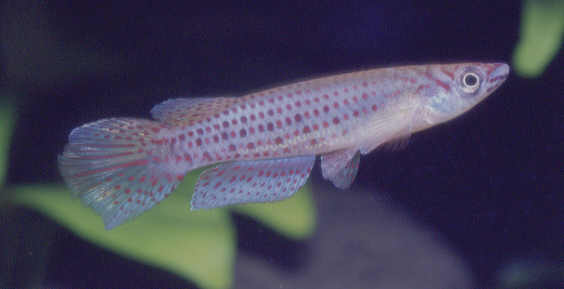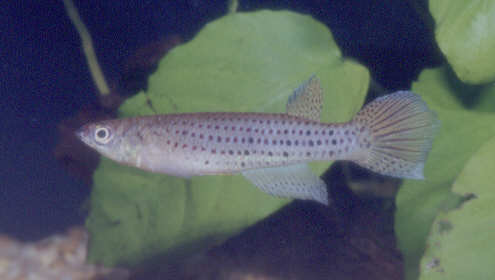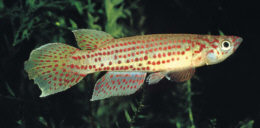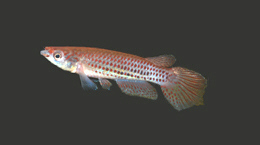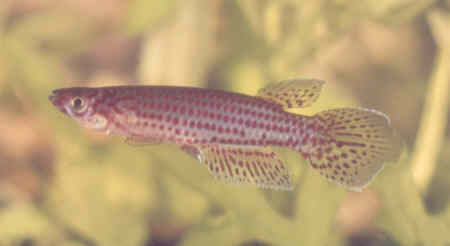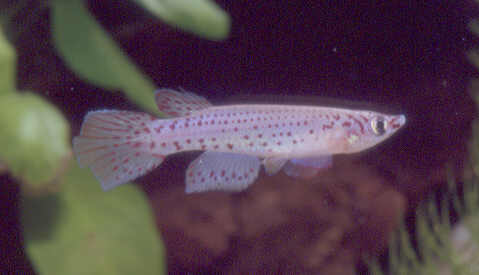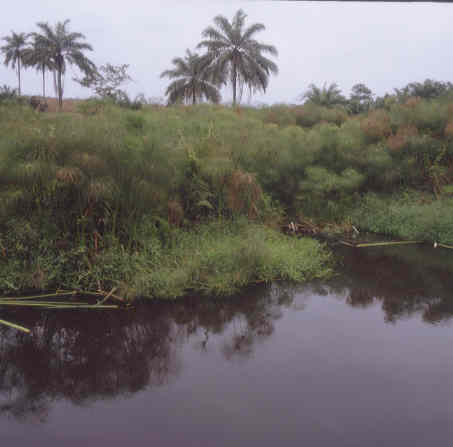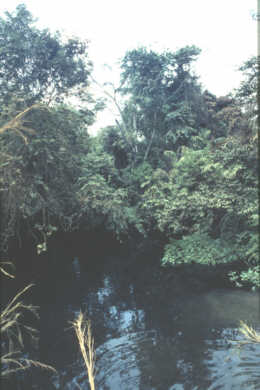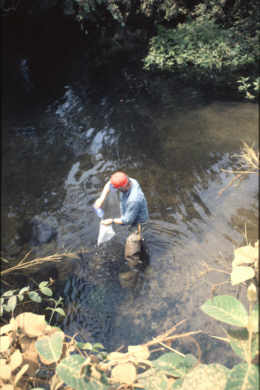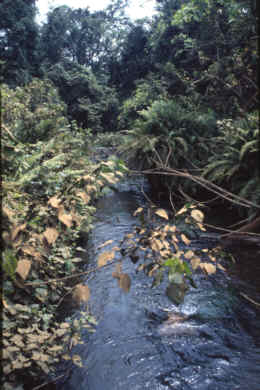Epiplatys singa (Boulenger 1899)
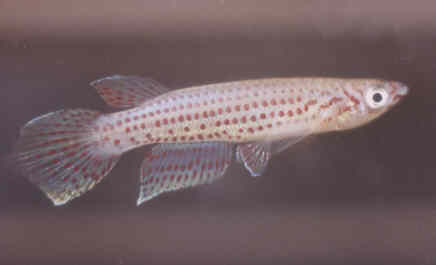
Fish bought at a BKA auction early '80's. No location on the bag.
| Meaning of Name |
After the local name for Epiplatys type fish - 'singa'. | |||||||||
| First Description |
Boulenger G.A. 1899. Matériaux pour la faune du Congo. Cinquiéme partie. Poissons nouveaux du Congo. Cyprins, Silures, Cyprinodontes, Acanthoptéryiens. Annales du Musée Royal du Congo Belge (Zoologie, Serie 1) 1 (5): p 113-114, plate 47, figure 1. | |||||||||
| Size |
6-7 cm. Huber reported (in BKA newsletter No.208) that older males caught near river banks were larger than this. | |||||||||
| Meristics |
| |||||||||
| Karyotype |
n = 21, A = 29 (Scheel 1990) | |||||||||
| Sub-Genus |
Epiplatys | |||||||||
| Group |
singa | |||||||||
| Synonyms |
| |||||||||
Populations
|
Boma - Received by the BKA around 1978. Also collected in 1982 ( Z 82 / 2 ).
Matadi - Received by the BKA around 1978. | |||||||||
| Type Locality |
A swamp close to Boma (see photo below), situated in the lower Zaire River drainage system). The type specimen was 45 mm in length. | |||||||||
| Distribution |
Coastal rainforest & forested savannah. In the north starting at southern Equatorial Guinea, through Gabon, into Congo & into Cabinda. They have also been reported from Angola. http://homepage.uibk.ac.at/homepage/c102/c102mr/epiplaty/singa.htm | |||||||||
| Habitat |
Small rivers, brooks & swamps. These
biotopes are generally on sand substrate with leaves. The water is clear &
calm. Diffused light is the usual norm.but they are found in areas brighter than
many forest dwelling Aphyosemion sp.
Collection
site of E.singa. Boma, Zaire.
| |||||||||
| Distinguishing Characteristics | A
species which, in the distant past, has been confused with E.grahami.
This is due to the horizontal lines of spots through the body. E.grahami has vertical bars in the body especially seen as a stress pattern. Also, this species has 'shiny green' eyes. |
|||||||||
| Colour/Pattern Variability | Probably low. This species has a large distribution area & no doubt variations will turn up in future collections. | |||||||||
| History |
Boulenger described this sp. in 1899 from one specimen
collected at Boma by Dr.J.W.Todd. In 1902 he reported 2 other specimens from the
Lindi River area near Stanleyville. In 1917 Nichols & Griscom reported around
12 specimens from Stanleyville which were caught in pools in a clear running river
which drained into the Tschimbo River. In 1933 Myers placed the sp. in the genus
Epiplatys but later (1924) considered they
may belong to Aphyosemion. Poll in 1952, removed
one of the preserved specimens (from Leopoldville) & placed it in schoutedeni.
He also stated that the holotype was badly damaged. Boulenger gives the following collectors / locations in his 1915 Catalogue.
Boulenger gives the following collectors / locations for the synonym Haplochilus macrostigma.in his 1915 Catalogue.
A import by BKA Species Import in August/September 1974 was identified & distributed as ansorgii. This identification was made in error & this sp. was most likely macrostigma, now regarded as a synonym of singa. This was probably the first import of this sp. into the UK. History of the synonym Haplochilus macrostigma Boulenger 1911. Boulenger's type specimen was caught
by Dr.W.J.Ansorge from the Lucola River area, Cabinda. He used this
to describe the species in 1911. In 1912 more specimens were caught
from Lundo on the Luali River & also from the Luculla River. Both
these rivers were affluents of the Chiloango River. In 1915 Boulenger
also had 4 specimens from Boma, Lower Congo. Five specimens were examined
by scheel from the Lubi River, these being collected by Ciskay in 1948. History of the synonym Panchax ornatus Ahl 1928. Ahl
described this sp. from a single specimen donated by Gerlack of Hamburg. It is
not known for certain where this fish originated from but Scheel considered it
to come from Gabon or French Congo. | |||||||||
| Breeding Notes |
I
found this species easy to maintain & breed. On all occasions the fish bred
in hard tap water (DH 8-10, pH 8) but softer water would undoubtedly work better.
They laid eggs in spawning mops (mostly in top mops). Water incubation takes about
14 days. Growth is a little slow with sexual maturity taking about 7-8 months.
First reports of breeding this sp. from the first BKA imports of the early 1970's indicated that this sp. was a little delicate & care had to excercised in water changing or topping up. It appeared that the water had to be identical. Eggs were laid on floating mops but a few were also seen on submerged willow root. Fry were small on hatching & needed infusoria as a first food. Fry were considered best left with the parents in a well planted tank as opposed to removing them to there own tank. Young fish are slow growing & first signs of sexing out were observed after 6 months. At 1·5 - 2 cm the young develop black chevron markings on the body which are replaced at the 3-4 cm stage by longitudinal lines characteristic of adult colouration. | |||||||||
| Diameter of Egg | 1 mm. | |||||||||
| Remarks |
Regarded as one of the more difficult Epiplatys. |
